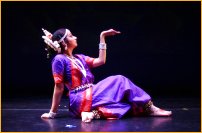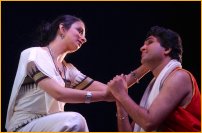 |
 |
CHAYANIKA BY SRISHTI DANCES OF INDIA by Vijay Palaparty, Pittsburgh e-mail: vkp@andrew.cmu.edu December 2002 |
 |
 |
| Srishti
Dances of India recently presented “Chayanika: Indian Classical Dance in
Odissi and Kathakali Styles” at the Kelly-Strayhorn Community Performing
Arts Center in Pittsburgh, Pennsylvania. On October 26th and 27th,
2002, the theater transformed into a rich and memorable tapestry of Indian
classical dance, music, and art.
The first half of the performance featured traditional pieces in the Odissi style of Eastern India. Sreyashi Dey, founder, president, and artistic director of Pittsburgh-based Srishti Dances of India along with several of her students, performed three traditional pieces. The first piece, Mangalacharan, included only her students and the second piece was a Pallavi in Aaravi Raga. Performed as a duet by Dey and Suhagi Jasani, the dancers enhanced the visual aspect of the piece by working with creative elements of the lighting design. The highlight of the first half was a 20-minute solo by Dey, Ardhanareeswara, a brilliant composition of Guru Kelucharan Mohapatra. Based on the concept of balance between male and female principles in the Universe, Dey marvellously expressed the aspects of the two Hindu divinities Shiva and Parvati in the rhythmically complex piece. The wide range of ragas combined with Dey’s grace and fluidity was amazing to witness. As the piece progressed, Dey was able to draw the audience more and more in to the piece – perhaps what is more than the dance itself. In the first half of Chayanika, Dey included a multimedia presentation of visual art by Calcutta-based mixed media artist Uday Hajra, and Pittsburgh visual artist Chitra Teredesai. The visual art component of the performance was effective because it supported the narration and better carried the audience through each piece. In Indian classical, there should be a strong balance between the music and the dance. The live orchestra ensemble, which is firstly a great feat to assemble for Odissi dance in the United States, generally performed well. However, at times the ensemble members were unsure and could have perhaps better communicated with Dey during the performance. The orchestra comprised of two vocalists, a violinist, a flautist, a sitar player, and a percussionist (pakhawaj). The second half of the performance was a powerful collaborative dance-theatre piece that fused Odissi and Kathakali dance and theatre styles, English theatre, and Hindustani classical music. Sreyashi Dey and Kathakali artist Ettumanoor Kannan from Trivandrum, India joined with Hindustani vocalist Charu Collur and Pittsburgh actors Brynell Jameson and Patrick Jordan to create a monumental work. The artists carefully chose elements from each of their respective art forms to create Karna and Kunti. A poignant story of the encounter between Karna and Kunti - the performance piece was based on an English translation of Nobel laureate poet Rabindranath Tagore’s original Bengali verse, and retains the main theme from Tagore’s original, specifically, the issues surrounding a mother attempting to reclaim her child whom she abandoned at birth. The main collaborators, Dey and Kannan, seemed to have focused more on the theme by using a minimalist and suggestive approach to their art form. Dey used a less stylized form and focused on the subtle yet powerful expressions of Odissi. Kannan very well controlled his theatrical form to closely meet the Odissi style. In the piece, the English dialogues were delivered by the actors who played parallel roles of Karna and Kunti. They created memorable moments by moving with Dey and Kannan – the dancers then had a voice, which made the characters more accessible to the audience. Charu Collur provided excellent vocal support for the piece. The only other musicians were a flautist and a percussionist (pakhawaj). Dey’s idea to use very simple costumes also added to the unexpected and complex simplicity of the piece – a sharp contrast from the first half of Chayanika. Karna and Kunti’s final scene was very emotional: the piece comes to an end when Karna’s chariot wheel gets stuck in the mud. Kunti witnesses the unspeakable horror of seeing Karna’s death when he is killed by her other son, Arjuna. A mellow raga and only two faint pools of light left the audience in shock. Karna and Kunti was recently premiered in Calcutta, in August 2002 to enthusiastic audience accolade and critical acclaim. Srishti Dances
of India ("Srishti") is a dance company whose mission is to disseminate
India's cultural heritage through performances of Indian classical dance,
music and theatre in both their traditional form, and through collaborations
with performing artists from around the world. In addition, the company
endeavors to educate and enhance audience appreciation of such classical
arts through exhibits, workshops, lecture-demonstrations, master classes,
multi-media presentations and academic presentations at national dance
conferences. Chayanika is not the first time that the company
has presented such superior and unsurpassed work.
Vijay Palaparty is a Bharatanatyam and Kuchipudi dancer based in Pittsburgh. |